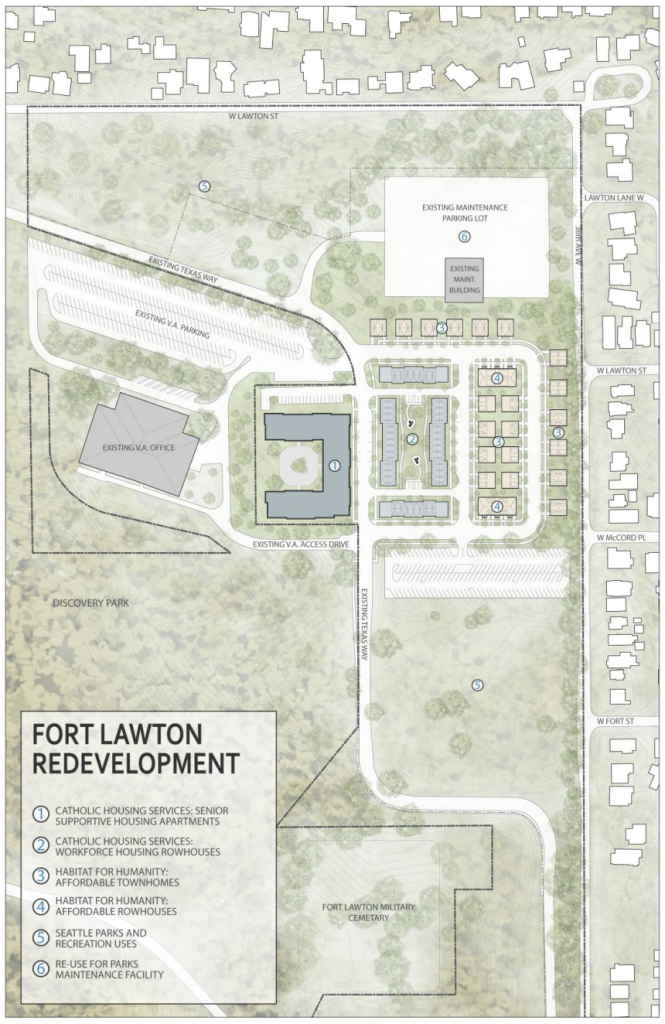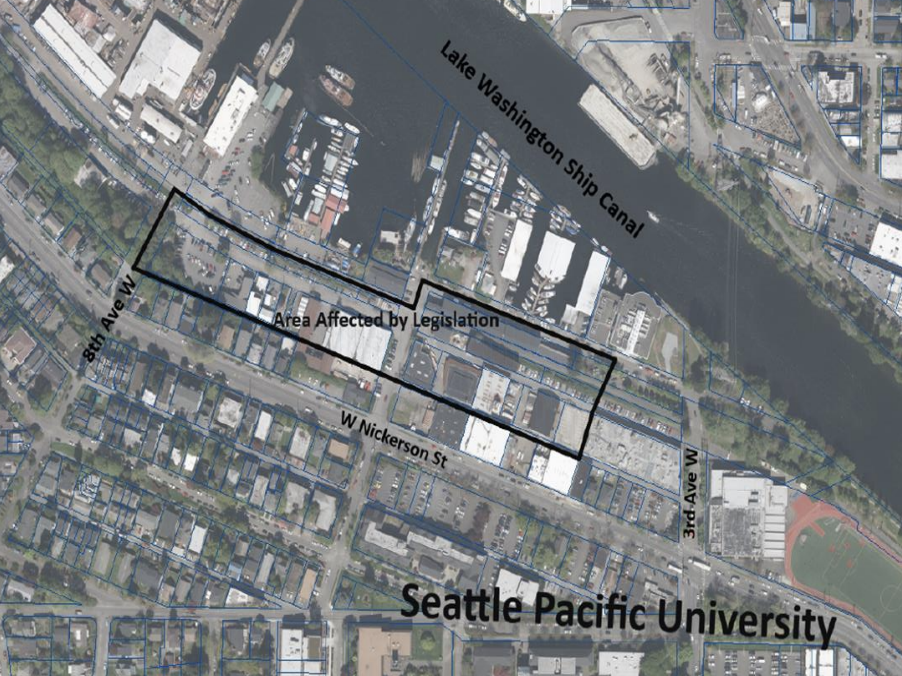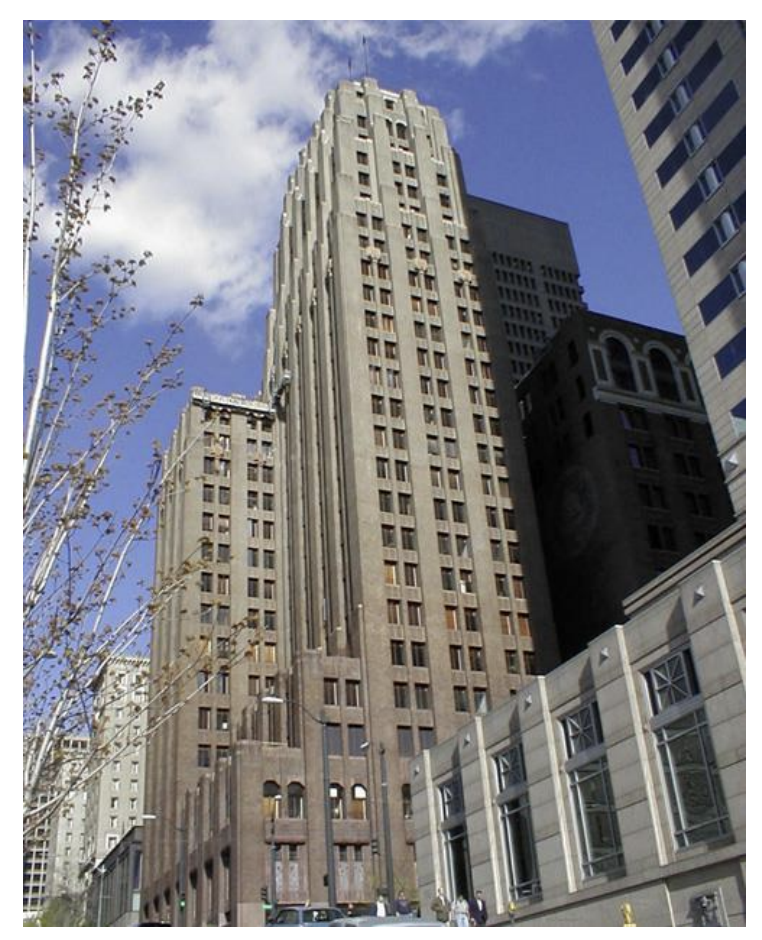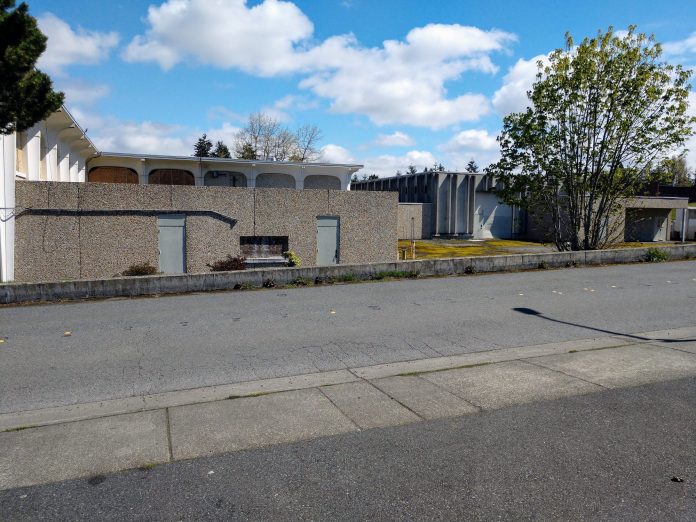On Monday, the Seattle City Council took a big step in approving a rezone and development plan for the Fort Lawton site. The legislation will pave the way for an affordable housing complex with more than 235 homes to move forward. The city council also extended what amounts to a moratorium to block redevelopment of the Showbox and several other pieces of land use and housing legislation.
Fort Lawton
The redevelopment area of Fort Lawton has been rezoned from single-family residential to Lowrise 2, which will the denser affordable multifamily project to proceed ahead. This culminated a 13-year process with many delays and appeals along the way. The city council adopted the recommended redevelopment plan proposed by the Seattle Office of Housing. According to the draft redevelopment plan, the housing mixture, tenure of households served, funding, and sponsors will include:
- 85 dwelling unit units for seniors. The units will be designed for supportive housing and set aside for households making at or below 30% of the area median income. Catholic Community Services of Western Washington and United Indians of All Tribes Foundation will sponsor these units. The total cost is estimated to be approximately $28.3 million with $9.1 million in funding coming from Seattle.
- Approximately 100 dwelling units will serve low-income families and individuals. The apartments will include some two- and three-bedroom units and serve households making up to 60% of the area median income. Catholic Community Services of Western Washington will sponsor these units. The total cost is estimated to be approximately $40.2 million with $7.7 million in funding coming from Seattle.
- Up to 52 “self-help” ownership homes. These dwellings will serve households making up to 80% of the area median income. Habitat for Humanity will sponsor these units. The total cost is estimated to be approximately $18.4 million with $4.7 million in funding coming from Seattle.
The proposed redevelopment, however, still suffers from lack of direct access to 30th Ave W. Residents will unnecessarily have to walk or bike long distances to access the local street network and other amenities.

Additionally, the city council adopted an agreement with Seattle Public Schools, which would allow redevelopment of multi-use athletic fields on the property.
Preservation of the Showbox
Preservation of the Showbox on First Avenue has been hotly contested. The owner of the building, Roger Forbes, had proposed a 44-story residential tower, pitting his redevelopment project against the famed music venue. City leaders sought to stall redevelopment and buy the music venue time by expending the Pike Place Market Historic District boundaries to the site and apply the preservation rules to the property on an interim basis until the city could complete work to create permanent regulations.
In the meantime, Forbes has signaled he will not extend the lease–potentially putting the future of the site as a music venue in jeopardy whether or not a redevelopment happens–and a preservation group has tried to buy the property. The property owner has also sought to overturn the interim regulations and seek damages from the city. On Monday, the city council extended the interim regulations through January 23, 2020.
Seattle Pacific University Amendments

To facilitate expansion of Seattle Pacific University north of Nickerson Street, the city council approved a new Major Institution Overlay and changes to land use regulations to allow the university to operate in industrial zones. The changes will affect about two blocks of parcels between Nickerson Street and the Lake Washington Ship Canal.
Other Land Use and Housing Legislation Approved
In 2018, the city council enacted a ban on bidding platforms like Rentberry and Bidwell to protect renters from rent inflation by bidding and unfair housing practices to favor applicants on the basis of ability to bid higher. The ban ended at the end of April, which led the city council to adopt a new version of the ban. The new version is essentially the same and extends the ban another year to give the Seattle Office of Housing time to evaluate the impacts of such bidding platforms and provide recommendations on how to regulate them.
In Capitol Hill and Ballard, revised design guidelines have been adopted. The updates were the outcome of extensive consultation with the neighborhoods to determine design priorities and provide better direction about how new development should fit in with the existing neighborhood contexts. Both neighborhoods have seen zoning changes in recent years and an extensive urban design framework was carried out in Ballard. Capitol Hill last version of neighborhood design guidelines were adopted in 2005 while Ballard’s were adopted in 2001. Naturally, the context for both has changed substantially during that time, leading to a need to take another look at the design guidelines.
Recent Council Actions

Last week, the city council approved three new landmarks. The first of these was the Seattle Tower, which is located on the corner of Third Avenue and University Street. The building was built in 1922 and the designation process began in 1977. Preservation controls apply to the building exterior and lobby.

Parrington Hall on the University of Washington Campus was also landmarked. The building was constructed in 1902 and is notable for its red brick and rounded wings and triangular center. Preservation controls apply to building exterior, several of portions of the building interior, and the immediate perimeter of the building.

Additionally, the Mount Baker Community Clubhouse has been landmarked. The building is of barrelled unique craftsman style and was constructed in 1914. Preservation controls apply to the building exterior and general site.

Finally, the city council upheld and approved a contract rezone in Phinney Ridge. The site is located on 12,188 square foot property at the corner of Greenwood Avenue N and N 70th St. The developer, 70th & Greenwood Ave, LLC, sought a rezone from Neighborhood Commercial 2 with a 40-foot height limit (NC2-40) to Neighborhood Commercial 2 with a 55-foot height limit and M Mandatory Housing Affordability suffix (NC2-55 (M)) in order to facilitate development of five-story mixed-use building. The developer plans to construct approximately 35 apartment units and include 5,550 square feet of ground floor retail.
However, local residents had tied the rezone and development up in an extensive appeal process. The King County Superior Court generally dismissed the case with the exception that the city council must address one rezone criterion: how the proposed development would make a gradual transition to the adjoining single-family residential area. As conditioned, landscape buffering will help ease the transition from mixed-use to single-family.
Stephen is a professional urban planner in Puget Sound with a passion for sustainable, livable, and diverse cities. He is especially interested in how policies, regulations, and programs can promote positive outcomes for communities. With stints in great cities like Bellingham and Cork, Stephen currently lives in Seattle. He primarily covers land use and transportation issues and has been with The Urbanist since 2014.



